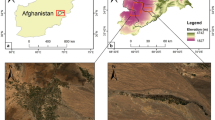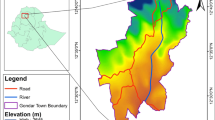Abstract
Floods cause substantial losses to life and property, especially in flood-prone regions like northwestern Bangladesh. Timely and precise evaluation of flood impacts is critical for effective flood management and decision-making. This research demonstrates an integrated approach utilizing machine learning and Google Earth Engine to enable real-time flood assessment. Synthetic aperture radar (SAR) data from Sentinel-1 and the Google Earth Engine platform were employed to generate near real-time flood maps of the 2020 flood in Kurigram and Lalmonirhat. An automatic thresholding technique quantified flooded areas. For land use/land cover (LULC) analysis, Sentinel-2’s high resolution and machine learning models like artificial neural networks (ANN), random forests (RF) and support vector machines (SVM) were leveraged. ANN delivered the best LULC mapping with 0.94 accuracy based on metrics like accuracy, kappa, mean F1 score, mean sensitivity, mean specificity, mean positive predictive value, mean negative value, mean precision, mean recall, mean detection rate and mean balanced accuracy. Results showed over 600,000 people exposed at peak inundation in July—about 17% of the population. The machine learning-enabled LULC maps reliably identified vulnerable areas to prioritize flood management. Over half of croplands flooded in July. This research demonstrates the potential of integrating SAR, machine learning and cloud computing to empower authorities through real-time monitoring and accurate LULC mapping essential for effective flood response. The proposed comprehensive methodology can assist stakeholders in developing data-driven flood management strategies to reduce impacts.







Similar content being viewed by others
Data availability
The datasets generated during and/or analysed in the current study can be available from the corresponding author on reasonable request.
References
Akhter J, Das L, Meher JK, Deb A (2019) Evaluation of different large-scale predictor-based statistical downscaling models in simulating zone-wise monsoon precipitation over India. Int J Climatol 39:465–482
Al Shoumik BA, Khan MZ, Islam MS (2023) Spatio-temporal characteristics of meteorological and agricultural drought indices and their dynamic relationships during the pre-monsoon season in drought-prone region of Bangladesh. Environ Challenges 11:100695
Alcántara-Ayala I (2002) Geomorphology, natural hazards, vulnerability and prevention of natural disasters in developing countries. Geomorphology 47:107–124
Ali MH, Bhattacharya B, Islam A et al (2019) Challenges for flood risk management in flood-prone Sirajganj region of Bangladesh. J Flood Risk Manag 12:e12450
Alshari EA, Abdulkareem MB, Gawali BW (2023) Classification of land use/land cover using artificial intelligence (ANN-RF). Front Artif Intell 5:964279
Anusha N, Bharathi B (2020) Flood detection and flood mapping using multi-temporal synthetic aperture radar and optical data. Egypt J Remote Sens Sp Sci 23:207–219
Bhattacharya A (1997) On the origin of non-tidal flaser bedding in point bar deposits of the river Ajay, Bihar and West Bengal, NE India. Sedimentology 44:973–975
Bui DT, Shahabi H, Shirzadi A et al (2018) Landslide detection and susceptibility mapping by AIRSAR data using support vector machine and index of entropy models in Cameron Highlands. Malaysia Remote Sens 10:1527
BWDB (2012) Annual flood report 2012. Flood Forecasting and Warning Centre, Bangladesh Water Development Board, Bangladesh. Retrieved December 20, 2022, from http://www.ffwc.gov.bd/index.php/reports/annual-flood-reports
Chowdhury MS (2024) Comparison of accuracy and reliability of random forest, support vector machine, artificial neural network and maximum likelihood method in land use/cover classification of urban setting. Environ Challenges 14:100800
Del Ninno C (2001) The 1998 floods in Bangladesh: disaster impacts, household coping strategies, and response. Intl Food Policy Res Inst 122
Doocy S, Daniels A, Murray S, Kirsch TD (2013) The human impact of floods: a historical review of events 1980-2009 and systematic literature review. PLoS Currents 5
FAO (2018) The state of world fisheries and aquaculture. Food and Agriculture Organization of the United Nations
Giustarini L, Vernieuwe H, Verwaeren J et al (2015) Accounting for image uncertainty in SAR-based flood mapping. Int J Appl Earth Obs Geoinf 34:70–77
Glago FJ (2021) Flood disaster hazards; causes, impacts and management: a state-of-the-art review. Natural Hazards-Impacts, Adjustments and Resilience. IntechOpen, 29–37
Hansana P, Guo X, Zhang S et al (2023) Flood analysis using multi-scale remote sensing observations in Laos. Remote Sens 15:3166
Hostache R, Matgen P, Schumann G et al (2009) Water level estimation and reduction of hydraulic model calibration uncertainties using satellite SAR images of floods. IEEE Trans Geosci Remote Sens 47:431–441
Jombo S, Adelabu S (2023) Evaluating Landsat-8, Landsat-9 and Sentinel-2 imageries in land use and land cover (LULC) classification in a heterogeneous urban area. GeoJournal 88:377–399
Kale VS, Hire P, Baker VR (1997) Flood hydrology and geomorphology of monsoon-dominated rivers: the Indian Peninsula. Water Int 22:259–265
Karra K, Kontgis C, Statman-Weil Z, Mazzariello JC, Mathis M, Brumby SP (2021) Global land use/land cover with Sentinel 2 and deep learning. In: 2021 IEEE international geoscience and remote sensing symposium IGARSS. IEEE, pp 4704–4707
Kuenzer C, Guo H, Huth J et al (2013) Flood mapping and flood dynamics of the Mekong Delta: ENVISAT-ASAR-WSM based time series analyses. Remote Sens 5:687–715
Kundzewicz ZW, Takeuchi K (1999) Flood protection and management: quo vadimus? Hydrol Sci J 44:417–432
Liang J, Liu D (2020) A local thresholding approach to flood water delineation using Sentinel-1 SAR imagery. ISPRS J Photogramm Remote Sens 159:53–62
Mallick J, Talukdar S, Pal S, Rahman A (2021) A novel classifier for improving wetland mapping by integrating image fusion techniques and ensemble machine learning classifiers. Ecol Inform 65:101426
Wahlstrom M, Guha-Sapir D (2015) The human cost of weather-related disasters 1995–2015. UNDRR. Retrieved December 20, 2022, from https://www.undrr.org/publication/human-cost-weather-related-disasters-1995-2015
Mirza MMQ (2002) Global warming and changes in the probability of occurrence of floods in Bangladesh and implications. Glob Environ Chang 12:127–138
Muramoto Y (1988) Investigation of the flood disaster caused by heavy rainfall in Bangladesh during the 1987 monsoon season. Rep. of Scientific Research for Natural Disaster, No. B-62, 5
Nijhawan R, Joshi D, Narang N et al (2019) A futuristic deep learning framework approach for land use-land cover classification using remote sensing imagery. In: Mandal JK, Bhattacharyya D, Auluck N (eds) Advanced Computing and Communication Technologies: Proceedings of the 11th ICACCT 2018. Springer, pp 87–96
Otsu N (1979) A threshold selection method from gray-level histograms. IEEE Trans Syst Man Cybern 9:62–66
Ouma Y, Nkwae B, Moalafhi D et al (2022) Comparison of machine learning classifiers for multitemporal and multisensor mapping of urban LULC features. Int Arch Photogramm Remote Sens Spat Inf Sci 43:681–689
Pal S, Talukdar S (2020) Assessing the role of hydrological modifications on land use/land cover dynamics in Punarbhaba river basin of Indo-Bangladesh. Environ Dev Sustain 22:363–382
Prasad P, Loveson VJ, Chandra P, Kotha M (2022) Evaluation and comparison of the earth observing sensors in land cover/land use studies using machine learning algorithms. Ecol Inform 68:101522
Roy SK, Sarker SC (2016) Integration of remote sensing data and GIS tools for accurate mapping of flooded area of Kurigram, Bangladesh. J Geogr Inf Syst 8:184–192
Saif Uddin M (2022) Analysis of the hydro-morphodynamic processes in relation with risk of sedimentation in tidal rivers of southwest Bangladesh. Post graduate dissertations (Thesis) of Institute of Water and Flood Management (IWFM). Bangladesh University of Engineering and Technology (BUET). Retrieved December 20, 2022, from http://lib.buet.ac.bd:8080/xmlui/handle/123456789/6558
Smith A, Bates PD, Wing O et al (2019) New estimates of flood exposure in developing countries using high-resolution population data. Nat Commun 10:1814
Smith LC (1997) Satellite remote sensing of river inundation area, stage, and discharge: a review. Hydrol Process 11:1427–1439
Stevens FR, Gaughan AE, Linard C, Tatem AJ (2015) Disaggregating census data for population mapping using random forests with remotely-sensed and ancillary data. PLoS ONE 10:e0107042
Talukdar S, Eibek KU, Akhter S et al (2021) Modeling fragmentation probability of land-use and land-cover using the bagging, random forest and random subspace in the Teesta River Basin. Bangladesh Ecol Indic 126:107612
Talukdar S, Singha P, Mahato S et al (2020) Land-use land-cover classification by machine learning classifiers for satellite observations—a review. Remote Sens 12:1135
Tatem AJ (2017) WorldPop, open data for spatial demography. Sci Data 4:1–4
Tehrany MS, Pradhan B, Jebur MN (2014) Flood susceptibility mapping using a novel ensemble weights-of-evidence and support vector machine models in GIS. J Hydrol 512:332–343
UNU (2004) Two billion will be in flood path by 2050, UNU expert warns. Update.unu.edu. Retrieved December 20, 2022, from https://archive.unu.edu/update/archive/issue32_2.htm
Xie G, Niculescu S (2021) Mapping and monitoring of land cover/land use (LCLU) changes in the crozon peninsula (Brittany, France) from 2007 to 2018 by machine learning algorithms (support vector machine, random forest, and convolutional neural network) and by post-classification c. Remote Sens 13:3899
Zhu S, Dai Q, Zhao B, Shao J (2020) Assessment of population exposure to urban flood at the building scale. Water 12:3253
Acknowledgements
Authors thankfully acknowledge the Deanship of Scientific Research for proving administrative and financial supports.
Funding
Authors thankfully acknowledge the Deanship of Scientific Research for proving administrative and financial supports. Funding for this research was given under award numbers RGP2/442/44 by the Deanship of Scientific Research; King Khalid University, Ministry of Education, Kingdom of Saudi Arabia.
Author information
Authors and Affiliations
Contributions
Nafis Sadik Khan and Sujit Kumar Roy: conceptualization; data curation; formal analysis; investigation; methodology; project administration; resources; software; supervision; validation; visualization; roles/writing—original draft; writing—review and editing. Swapan Talukdar: conceptualization; methodology; visualization; roles/writing—original draft; writing—review and editing, data wrangling. Md. Mostaim Billah, Ashik Iqbal and Rashed Uz Zzaman: Resources; supervision; investigation, validation; visualization, writing—review and editing. Md. Arif Chowdhury: roles/writing—original draft. Sania B Mahtab and Javed Mallick: investigation, supervision, writing—review ang editing. All authors read and approved the final manuscript.
Corresponding author
Ethics declarations
Ethical approval
Not applicable.
Consent to participate
Not applicable.
Consent for publication
Not applicable.
Competing interests
The authors declare no competing interests.
Additional information
Responsible Editor: Philippe Garrigues
Publisher's Note
Springer Nature remains neutral with regard to jurisdictional claims in published maps and institutional affiliations.
Rights and permissions
Springer Nature or its licensor (e.g. a society or other partner) holds exclusive rights to this article under a publishing agreement with the author(s) or other rightsholder(s); author self-archiving of the accepted manuscript version of this article is solely governed by the terms of such publishing agreement and applicable law.
About this article
Cite this article
Khan, N.S., Roy, S.K., Talukdar, S. et al. Empowering real-time flood impact assessment through the integration of machine learning and Google Earth Engine: a comprehensive approach. Environ Sci Pollut Res (2024). https://doi.org/10.1007/s11356-024-33090-7
Received:
Accepted:
Published:
DOI: https://doi.org/10.1007/s11356-024-33090-7




